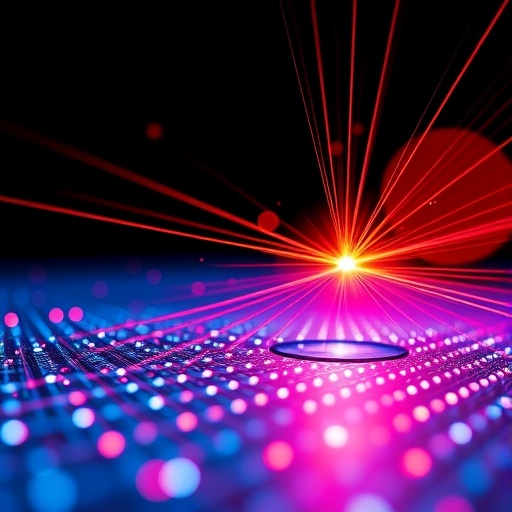In a groundbreaking advance that pushes the boundaries of ultrafast physics and photonics, researchers from the Politecnico di Milano have unveiled a novel understanding of how light interacts with matter on attosecond timescales. Published recently in Nature Photonics, this research highlights the crucial influence of virtual charge carriers—ephemeral entities that exist only transiently during light-matter interaction—on the optical response of dielectrics. This revelation challenges longstanding beliefs that rapid electronic responses within solids arise solely from the behavior of real, mobile charges.
The team’s investigation focused on monocrystalline diamonds, a prototypical dielectric material, subjected to ultrashort laser pulses lasting mere attoseconds. Attoseconds, which are quintillionths of a second, allow observation and manipulation of electronic dynamics at their fundamental timescale. Using an advanced technique known as attosecond-scale transient reflection spectroscopy, the researchers could capture ultrafast changes in the optical properties of the diamond as it interacted with these fleeting light bursts.
Crucially, the analysis delineated the role of virtual vertical electronic transitions—temporary excitations between electronic bands that do not involve the permanent promotion of electrons into conduction states but nonetheless affect the optical susceptibility of the material. These virtual states, though transient and without a classical particle interpretation, modulate the dielectric response in a way that was previously overlooked yet essential for accurately modeling the instantaneous refractive index changes and reflectivity.
Matteo Lucchini, a leading physicist at the Department of Physics of Politecnico di Milano and senior author of the study, emphasized that capturing the dynamics of virtual carriers is indispensable for precise prediction of ultrafast optical phenomena. His team’s breakthrough underscores that electron dynamics in solids are not merely the sum of actual charge carrier motions but also include these virtual electronic coherence effects developing on attosecond timescales.
The implications of this work extend far beyond academic curiosity. Mastering light-matter interaction at attosecond scales and incorporating virtual charge dynamics open exciting avenues for ultra-fast electronic technologies. Devices capable of operating at petahertz frequencies—thousands of times faster than today’s fastest processors—stand to benefit enormously. Such advancements could revolutionize signal processing and computing, shrinking latency to previously inconceivable levels.
To achieve this level of insight, the team combined cutting-edge experimental approaches with state-of-the-art numerical simulations. Their computational models meticulously replicated the ultrafast electron dynamics under intense light fields, isolating contributions from both real and virtual charge carriers. This synergistic approach proved vital for disentangling complex transient phenomena and validating the physical interpretation of the measurements.
This research was conducted within the Attosecond Research Center (ARC) at Politecnico di Milano, leveraging collaborative expertise from the University of Tsukuba, the Max Planck Institute for the Structure and Dynamics of Matter, and the Institute of Photonics and Nanotechnology (CNR-IFN). The work forms part of the broader ERC AuDACE project, focusing on attosecond dynamics in advanced materials, as well as the MIUR FARE PHorTUNA initiative targeting ultrafast phase transition dynamics in Mott insulators.
The discovery redefines our conceptual framework for interpreting ultrafast optical effects in dielectrics and semiconductors, where previously fast modulations were simply attributed to the movement and scattering of free carriers. Instead, the team has illuminated the transient quantum coherence phenomena governed by virtual charges, revealing a layer of complexity essential for designing next-generation photonic components.
Potential applications abound in developing ultra-fast optical switches, modulators, and transistors that can manipulate light signals on femtosecond and attosecond timescales, effectively bridging the gap between photonics and electronics. This could dramatically enhance data transmission speeds, energy efficiency, and information processing capacity across telecommunications, computing, and sensing technologies.
In addition to advancing technology, the findings enrich fundamental physics by demonstrating how ephemeral quantum states shape observable macroscopic properties in solid-state materials. This not only challenges conventional paradigms but also opens new paths for experimental and theoretical research into quantum coherence and non-equilibrium dynamics in condensed matter systems.
Ultimately, this pioneering study underscores the tremendous power of attosecond science, catalyzing a new era where the quantum subtleties of virtual charges are harnessed to transcend current limits in speed and functionality of electronic and photonic devices. As experimental capabilities continue to improve, the detailed control and exploitation of such ultrafast phenomena promise to become central to future breakthroughs in material science and quantum technologies.
Subject of Research: Attosecond dynamics and virtual charge carrier contributions in light-matter interaction within dielectrics
Article Title: Attosecond virtual charge dynamics in dielectrics
News Publication Date: 26 September 2025
Web References: DOI: 10.1038/s41566-025-01700-6
Image Credits: Politecnico di Milano
Keywords
Accelerator physics, Particle physics, Energy, Energy transfer, Technology, Optoelectronics




